Biology
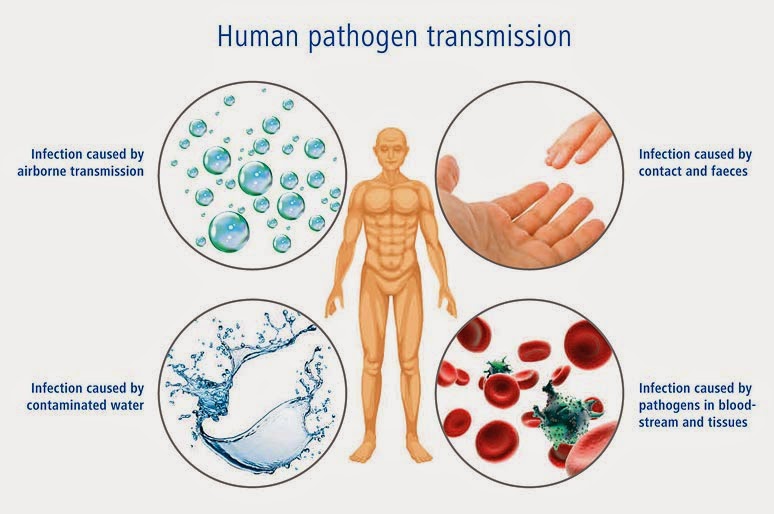 1 The term disease is defined as a disorder or illness that disrupts the normal functioning of the body or mind. Infectious diseases are caused by organisms known as pathogens that invade the body. Non-infectious diseases are all other diseases that are not caused by pathogens. There are many categories of non-infectious diseases including genetic diseases and deficiency diseases, which are caused by malnutrition.
1 The term disease is defined as a disorder or illness that disrupts the normal functioning of the body or mind. Infectious diseases are caused by organisms known as pathogens that invade the body. Non-infectious diseases are all other diseases that are not caused by pathogens. There are many categories of non-infectious diseases including genetic diseases and deficiency diseases, which are caused by malnutrition.
2 Cholera, malaria, HIV/AIDS, tuberculosis (TB) and measles are all examples of infectious diseases. Smallpox was an infectious disease but was eradicated in the late 20th century.
3 Cholera is caused by the bacterium Vibrio choleraeand is transmitted in water or food contaminated by the faeces of infected people.
4 Cholera can be controlled by treating patients with oral rehydration therapy and making sure that human faeces do not reach the water supply. The disease is prevented by providing clean, chlorinated water and good sanitation.
5 Malaria is caused by four species of Plasmodium. The most dangerous is P. falciparum. The disease is transmitted by an insect vector: female Anopheles mosquitoes that transfer Plasmodium from infected to uninfected people.
6 Malaria is controlled in three main ways: by reducing the number of mosquitoes by insecticide spraying or draining breeding sites; by using mosquito nets (more eff ective if soaked in insecticide); by using drugs to prevent Plasmodium infecting people.
7 AIDS is a set of diseases caused by the destruction of the immune system by infection with human immunodefi ciency virus (HIV). HIV is transmitted in certain body fluids: blood, semen, vaginal secretions and breast milk. It primarily infects economically active members of populations in developing countries and has an extremely adverse effect on social and economic development.
8 The transmission of HIV can be controlled by using barrier methods (e.g. condoms and femidoms) during sexual intercourse. Educating people to practise safer sex is the only control method currently available to health authorities. Contact tracing is used to find people who may have contracted HIV, so that they can be tested and counselled. Life expectancy can be greatly extended by using combinations of drugs which interfere with the replication of the virus. However, such treatment is expensive, difficult to stick to and has unpleasant side-eff ects. There is no vaccine for HIV and no cure for AIDS.
9 TB is caused by the bacteria Mycobacterium tuberculosis and M. bovis.
10 M. tuberculosis is spread when people infected with the active form of the disease release bacteria in droplets of liquid when they cough or sneeze. Transmission occurs when uninfected people inhale the bacteria. Th is is most likely to happen where people live in overcrowded conditions, and especially where many sleep close together. Many people have the inactive form of TB in their lungs, but they do not have the disease and do not spread it. The inactive bacteria may become active in people who are malnourished or who become infected with HIV. M. bovis causes TB in cattle, but can be passed to humans.
11 Drugs are used to treat people with the active form of TB. The treatment may take nine months or more as it is difficult to kill the bacteria. Contact tracing is used to find people who may have caught the disease. These people are tested for TB and treated if found to be infected. The BCG vaccine provides some protection against TB, but its eff ectiveness varies in diff erent parts of the world.
12 Public health measures are taken to reduce the transmission of these diseases, but to be eff ective they must be informed by a knowledge of the life cycle of each pathogen.
13 Antibiotics are drugs that are used to treat infections by bacteria and some fungi. They are compounds that are made by microorganisms and modified chemically to increase their effectiveness.
14 Antibiotics are used to inhibit the growth of pathogenic organisms. Most are only eff ective against bacteria. The widespread and indiscriminate use of antibiotics has led to the growth of resistant strains of bacteria. This poses a serious challenge to the maintenance of health services in the 21st century.
1 Which diseases can be transmitted from infected to uninfected people?
A cholera and malaria
B lung cancer and tuberculosis
C measles and sickle cell anaemia
D sickle cell anaemia and smallpox
2 Which row matches pathogens with the diseases they cause?

3 How are the diseases cholera, malaria, TB and HIV/AIDS transmitted?
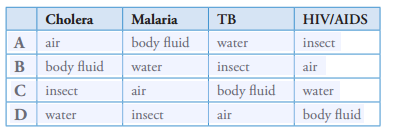
4 Which treatment would not help villagers control the spread of malaria?
A draining nearby marshes and covering water surfaces with oil
B stocking ponds and ditches with fish that eat insect larvae
C sleeping under nets treated with insecticide
D taking preventative drugs to which Plasmodium has developed resistance
5 Which measure would help control the spread of TB?
A preventing overcrowded conditions
B provision of clean water
C sewage treatment
D use of insecticides
6 Which statements describe the transmission of human immunodeficiency virus (HIV) from an infected to an uninfected person?
1 It is transmitted by a vector.
2 It is transmitted by intimate human contact.
3 It is transmitted by sharing intravenous injection needles.
4 It is transmitted across the placenta from mother to fetus.
A 1, 2, 3 and 4
B 2, 3 and 4 only
C 1 and 3 only
D 3 and 4 only
7 Which statements explain why injections of vaccine may not provide protection against Vibrio cholerae?
1 V. cholerae bacteria infect the intestine.
2 The toxin produced by V. cholerae acts within the intestine.
3 A vaccine providing protection against one strain of V. cholerae may not provide protection against another strain.
A 1, 2 and 3
B 1 and 2 only
C 2 and 3 only
D 3 only
8 What explains why measles is not treated with an antibiotic?
A The pathogen causing measles can break down the antibiotic.
B The pathogen causing measles has become resistant to the antibiotic.
C The pathogen causing measles has no cellular structure.
D The pathogen causing measles is too large to be affected by an antibiotic.
9 The malarial parasite must enter a red blood cell to divide and multiply. To enter, the parasite binds to a protein called basigin on the cell surface membrane of the red blood cell. What could prevent the parasite from entering a red blood cell?
A an antibiotic that inhibits the synthesis of bacterial cell walls
B an antiviral drug that prevents the parasite from multiplying
C a molecule which binds to basigin and blocks its binding site
D a molecule which binds to the cell surface membranes of mosquito cells
Answers to Multiple choice test
- # 62 Immunity And Vaccination
A person is immune to a disease if the pathogen that causes the disease is unable to reproduce in the body and cause illness. This happens when the body already contains, or is able rapidly to make, large quantities of antibodies against the antigens...
- #57.2 Immunity - Syllabus 2016
11.1 The immune system 11.2 Antibodies and vaccination An understanding of the immune system shows how cells and molecules function together to protect the body against infectious diseases and how the body is protected from further...
- #55 Infectious Diseases And Antibiotics
An infectious disease is one that can be passed between one person and another. Infectious diseases are caused by pathogens. These are usually microorganisms such as viruses, bacteria, fungi or protoctists. A non-infectious disease cannot be passed between...
- # 54.1 Infectious Disease - Syllabus 2015
? Cholera, malaria, tuberculosis (TB), HIV/AIDS, smallpox and measles ? Antibiotics Learning Outcomes Candidates should be able to: (a) define the term disease and explain the difference between an infectious disease and non-infectious diseases; ...
- Human Health And Infectious Diseases
Health is a state of complete physical, mental & social well-being. Health is affected by genetic disorders, Infections, change in life style (food, water, rest, exercise, habits etc).Diseases may be Infectious or Non-infectious. Pathogens: Disease...
Biology
# 56 Summary of Infectious diseases and Antibiotics

2 Cholera, malaria, HIV/AIDS, tuberculosis (TB) and measles are all examples of infectious diseases. Smallpox was an infectious disease but was eradicated in the late 20th century.
3 Cholera is caused by the bacterium Vibrio choleraeand is transmitted in water or food contaminated by the faeces of infected people.
4 Cholera can be controlled by treating patients with oral rehydration therapy and making sure that human faeces do not reach the water supply. The disease is prevented by providing clean, chlorinated water and good sanitation.
5 Malaria is caused by four species of Plasmodium. The most dangerous is P. falciparum. The disease is transmitted by an insect vector: female Anopheles mosquitoes that transfer Plasmodium from infected to uninfected people.
6 Malaria is controlled in three main ways: by reducing the number of mosquitoes by insecticide spraying or draining breeding sites; by using mosquito nets (more eff ective if soaked in insecticide); by using drugs to prevent Plasmodium infecting people.
7 AIDS is a set of diseases caused by the destruction of the immune system by infection with human immunodefi ciency virus (HIV). HIV is transmitted in certain body fluids: blood, semen, vaginal secretions and breast milk. It primarily infects economically active members of populations in developing countries and has an extremely adverse effect on social and economic development.
8 The transmission of HIV can be controlled by using barrier methods (e.g. condoms and femidoms) during sexual intercourse. Educating people to practise safer sex is the only control method currently available to health authorities. Contact tracing is used to find people who may have contracted HIV, so that they can be tested and counselled. Life expectancy can be greatly extended by using combinations of drugs which interfere with the replication of the virus. However, such treatment is expensive, difficult to stick to and has unpleasant side-eff ects. There is no vaccine for HIV and no cure for AIDS.
9 TB is caused by the bacteria Mycobacterium tuberculosis and M. bovis.
10 M. tuberculosis is spread when people infected with the active form of the disease release bacteria in droplets of liquid when they cough or sneeze. Transmission occurs when uninfected people inhale the bacteria. Th is is most likely to happen where people live in overcrowded conditions, and especially where many sleep close together. Many people have the inactive form of TB in their lungs, but they do not have the disease and do not spread it. The inactive bacteria may become active in people who are malnourished or who become infected with HIV. M. bovis causes TB in cattle, but can be passed to humans.
11 Drugs are used to treat people with the active form of TB. The treatment may take nine months or more as it is difficult to kill the bacteria. Contact tracing is used to find people who may have caught the disease. These people are tested for TB and treated if found to be infected. The BCG vaccine provides some protection against TB, but its eff ectiveness varies in diff erent parts of the world.
12 Public health measures are taken to reduce the transmission of these diseases, but to be eff ective they must be informed by a knowledge of the life cycle of each pathogen.
13 Antibiotics are drugs that are used to treat infections by bacteria and some fungi. They are compounds that are made by microorganisms and modified chemically to increase their effectiveness.
14 Antibiotics are used to inhibit the growth of pathogenic organisms. Most are only eff ective against bacteria. The widespread and indiscriminate use of antibiotics has led to the growth of resistant strains of bacteria. This poses a serious challenge to the maintenance of health services in the 21st century.
1. Multiple-choice test
1 Which diseases can be transmitted from infected to uninfected people?
A cholera and malaria
B lung cancer and tuberculosis
C measles and sickle cell anaemia
D sickle cell anaemia and smallpox
2 Which row matches pathogens with the diseases they cause?

3 How are the diseases cholera, malaria, TB and HIV/AIDS transmitted?

4 Which treatment would not help villagers control the spread of malaria?
A draining nearby marshes and covering water surfaces with oil
B stocking ponds and ditches with fish that eat insect larvae
C sleeping under nets treated with insecticide
D taking preventative drugs to which Plasmodium has developed resistance
5 Which measure would help control the spread of TB?
A preventing overcrowded conditions
B provision of clean water
C sewage treatment
D use of insecticides
6 Which statements describe the transmission of human immunodeficiency virus (HIV) from an infected to an uninfected person?
1 It is transmitted by a vector.
2 It is transmitted by intimate human contact.
3 It is transmitted by sharing intravenous injection needles.
4 It is transmitted across the placenta from mother to fetus.
A 1, 2, 3 and 4
B 2, 3 and 4 only
C 1 and 3 only
D 3 and 4 only
7 Which statements explain why injections of vaccine may not provide protection against Vibrio cholerae?
1 V. cholerae bacteria infect the intestine.
2 The toxin produced by V. cholerae acts within the intestine.
3 A vaccine providing protection against one strain of V. cholerae may not provide protection against another strain.
A 1, 2 and 3
B 1 and 2 only
C 2 and 3 only
D 3 only
8 What explains why measles is not treated with an antibiotic?
A The pathogen causing measles can break down the antibiotic.
B The pathogen causing measles has become resistant to the antibiotic.
C The pathogen causing measles has no cellular structure.
D The pathogen causing measles is too large to be affected by an antibiotic.
9 The malarial parasite must enter a red blood cell to divide and multiply. To enter, the parasite binds to a protein called basigin on the cell surface membrane of the red blood cell. What could prevent the parasite from entering a red blood cell?
A an antibiotic that inhibits the synthesis of bacterial cell walls
B an antiviral drug that prevents the parasite from multiplying
C a molecule which binds to basigin and blocks its binding site
D a molecule which binds to the cell surface membranes of mosquito cells
Answers to Multiple choice test
1. A
2. A
3. D
4. D
5. A
6. B
7. A
8. C
9. C
2. End-of-chapter questions
1 Cholera, malaria, measles and tuberculosis (TB) are infectious diseases. Which row shows the type of organism that causes each of these diseases?

2 Non-infectious diseases are best defined as:
A diseases caused by malnutrition
B all diseases of old age
C all diseases that are not caused by a pathogen
D all diseases that can be transmitted from mother to child.
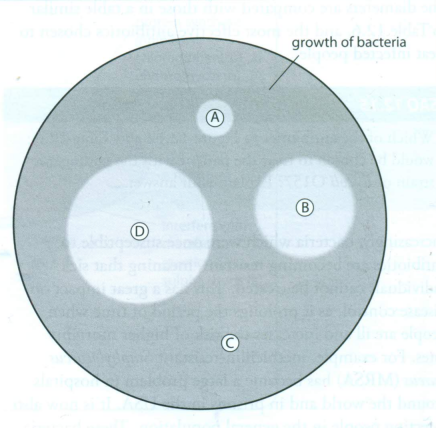 3 An antibiotic sensitivity test was carried out on bacteria isolated from a patient with a blood disease. Four antibiotics were tested, A, B, C and D. The results are shown in the figure.
3 An antibiotic sensitivity test was carried out on bacteria isolated from a patient with a blood disease. Four antibiotics were tested, A, B, C and D. The results are shown in the figure.
Which antibiotic should be chosen to treat the blood disease?
4 Which of the following diseases is transmitted by an insect vector?
A cholera
B HIV/AIDS
C malaria
D TB
5 a State three ways in which HIV is transmitted.
The table shows statistics for four regions of the world and the global totals for HIV/AIDS in 2010. [3]
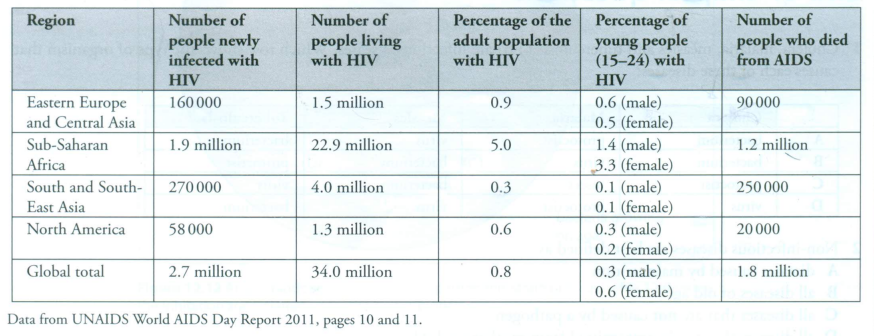
b Suggest three sources of data that UNAIDS may use to compile the data in the table. [3]
c Explain why it is important to collect the data on the HIV/AIDS pandemic shown in the table [3]
d i For North America, the ratio of the number of people dying from AIDS to the number of people living with HIV in 2010 was 20000:1.3 million or 0.015: 1.
Calculate the ratio for sub-Saharan Africa. [1]
ii Suggest reasons for the difference between the ratios for North America and sub-Saharan Africa. [3]
[Total: 13]
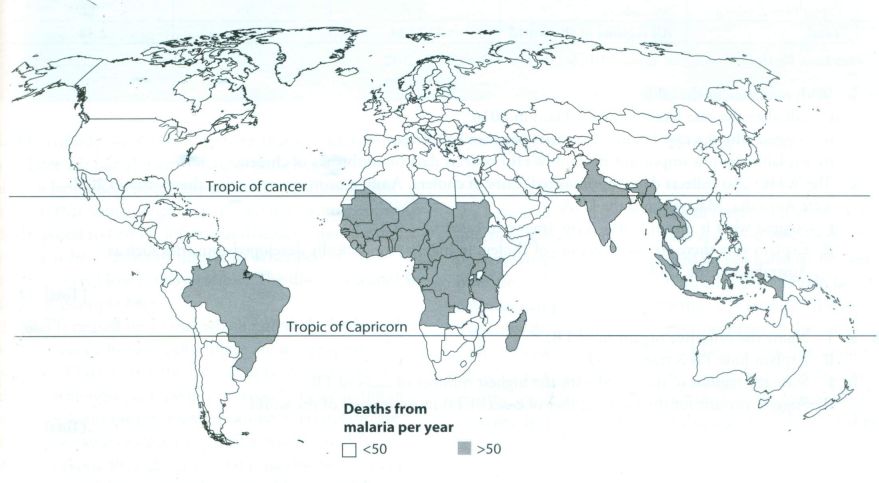
b Describe and explain the global distribution of malaria. [5]
c Outline the biological reasons for the difficulties in developing and introducing control methods for malaria. [6]
7 a Describe how cholera is transmitted. [2]
The table shows the number of cases of cholera and deaths from the disease for the five countries with the greatest outbreaks as reported to the WHO in 2010.

b With reference to the table:
1 A
2 C
3 D
4 C
Exam-style questions

5 a unprotected sexual intercourse;
sharing needles (between intravenous drug users)/ re-use of unsterilised needles;
blood transfusion/blood products;
(mother to child) across the placenta/at birth/in breast milk; [max. 3]
b doctors?/hospital records;
tests for HIV status (e.g. at antenatal clinics for pregnant women);
death certifi cates; [3]
c to determine how numbers of people infected are changing;
to see where medical resources should be targeted;
e.g. drugs for treating HIV infection;
to monitor success of HIV/AIDS programmes in reducing spread of HIV infection;
and in treating people who are HIV+ so they do not develop AIDS;
to see if more education is required;
to provide support to national/regional health organisations; [max. 3]
d i 0.052 : 1; [1]
ii better health care in North America;
better diagnosis, so people who are HIV+ start treatment early;
more affl uent countries, so drugs available to (nearly) all people who are HIV+; [3]
[Total: 13]
6 a female Anopheles (mosquito);
takes a blood meal from an infected person;
transfers, parasite/pathogen/Plasmodium, in saliva when takes a blood meal from an uninfected person; [3]
b distribution: malaria occurs, between the tropics/tropics and sub-tropics/in equatorial regions/South and Central America, Africa and SE Asia; [1]
explanation:
1 Cholera, malaria, measles and tuberculosis (TB) are infectious diseases. Which row shows the type of organism that causes each of these diseases?

2 Non-infectious diseases are best defined as:
A diseases caused by malnutrition
B all diseases of old age
C all diseases that are not caused by a pathogen
D all diseases that can be transmitted from mother to child.
 3 An antibiotic sensitivity test was carried out on bacteria isolated from a patient with a blood disease. Four antibiotics were tested, A, B, C and D. The results are shown in the figure.
3 An antibiotic sensitivity test was carried out on bacteria isolated from a patient with a blood disease. Four antibiotics were tested, A, B, C and D. The results are shown in the figure.Which antibiotic should be chosen to treat the blood disease?
4 Which of the following diseases is transmitted by an insect vector?
A cholera
B HIV/AIDS
C malaria
D TB
5 a State three ways in which HIV is transmitted.
The table shows statistics for four regions of the world and the global totals for HIV/AIDS in 2010. [3]

b Suggest three sources of data that UNAIDS may use to compile the data in the table. [3]
c Explain why it is important to collect the data on the HIV/AIDS pandemic shown in the table [3]
d i For North America, the ratio of the number of people dying from AIDS to the number of people living with HIV in 2010 was 20000:1.3 million or 0.015: 1.
Calculate the ratio for sub-Saharan Africa. [1]
ii Suggest reasons for the difference between the ratios for North America and sub-Saharan Africa. [3]
[Total: 13]
6 a Describe how malaria is transmitted.
The figure shows the global distribution of malaria in 2010.

b Describe and explain the global distribution of malaria. [5]
c Outline the biological reasons for the difficulties in developing and introducing control methods for malaria. [6]
[Total: 14]
The table shows the number of cases of cholera and deaths from the disease for the five countries with the greatest outbreaks as reported to the WHO in 2010.

b With reference to the table:
i calculate the case fatality rate for Haiti in 2010 [1]
ii suggest why the case fatality rate varies between countries [3]
iii explain why it is important that the WHO collects data on outbreaks of cholera. [3]
c The WHO also collects data on 'imported' cases of cholera. Among countries reporting these cases in 2010 were Australia, Malaysia and the USA.
i Suggest what is meant by the term 'imported case'. [1]
ii Explain why there are no epidemics of cholera in highly economically developed countries such as Australia and the USA. [2]
[Total: 12]
8 a i Name the causative organism of TB. [1]
ii Explain how TB is transmitted. [2]
b i State the regions of the world with the highest number of cases of TB. [3]
ii Suggest reasons for the high number of cases of TB in some parts of the world. [4]
[Total: 10]
3. End-of-chapter answers
2 C
3 D
4 C
Exam-style questions

5 a unprotected sexual intercourse;
sharing needles (between intravenous drug users)/ re-use of unsterilised needles;
blood transfusion/blood products;
(mother to child) across the placenta/at birth/in breast milk; [max. 3]
b doctors?/hospital records;
tests for HIV status (e.g. at antenatal clinics for pregnant women);
death certifi cates; [3]
c to determine how numbers of people infected are changing;
to see where medical resources should be targeted;
e.g. drugs for treating HIV infection;
to monitor success of HIV/AIDS programmes in reducing spread of HIV infection;
and in treating people who are HIV+ so they do not develop AIDS;
to see if more education is required;
to provide support to national/regional health organisations; [max. 3]
d i 0.052 : 1; [1]
ii better health care in North America;
better diagnosis, so people who are HIV+ start treatment early;
more affl uent countries, so drugs available to (nearly) all people who are HIV+; [3]
[Total: 13]
6 a female Anopheles (mosquito);
takes a blood meal from an infected person;
transfers, parasite/pathogen/Plasmodium, in saliva when takes a blood meal from an uninfected person; [3]
b distribution: malaria occurs, between the tropics/tropics and sub-tropics/in equatorial regions/South and Central America, Africa and SE Asia; [1]
explanation:
Anopheles/mosquito/vector, distributed throughout tropical regions;
Plasmodium falciparum cannot complete its life cycle within mosquitoes at temperatures less than 20 °C;
Anopheles needs high rainfall/high humidity/ standing water;
Anopheles lays eggs in water;
no transmission at high altitude;
as too cold for parasite to complete life cycle;
no transmission in deserts; as no breeding grounds for mosquitoes; [max. 4]
c
Plasmodium is intracellular parasite; inside red blood cells/liver cells; antigenic concealment; antibodies are ineff ective; short stage in plasma when antibodies are eff ective;
Plasmodiumis eukaryotic; has many genes/ antigens; difficult to develop a vaccine; resistance to drugs used to treat malaria/as prophylactics; example of drug;
Anopheles/vector breeds in small pools of water; difficult to control all breeding places; mosquitoes come into contact with humans; mosquitoes become resistant to insecticides; [max. 6]
[Total: 14]
7
a bacteria pass out in faeces of infected person; carried in water/food consumed by uninfected person; [2]
b i 2.22; [1]
ii treatment for cholera involves supply of oral rehydration therapy/ORT; and provision of safe drinking water;
better response to emergencies (in some countries);
effectiveness of response may depend on number of cases;
reference to very high number of cases in Haiti;
may depend on remoteness of regions affected by cholera;
or ways in which emergency supplies/ personnel can reach aff ected areas; reference to high case fatality rates in Nigeria/ Cameroon;
use of data to compare case fatality rates in individual country with global rate; [max. 3]
iii cholera is a serious disease;
death can occur very quickly after infection;
spreads quickly in population (especially after a disaster);
deaths are avoidable;
if ORT is available immediately;
data is useful to predict situations/places where cholera may occur;
WHO can coordinate responses to outbreaks; [max. 3]
c i infected person travelled from an area with an outbreak of cholera; [1]
ii water supply is not contaminated with (human) sewage/faeces;
piped water/water supply is treated to kill bacteria;
V. cholerae destroyed in sewage treatment; [max. 2]
[Total: 12]
8 a i Mycobacterium tuberculosis; [1]
ii infected person, coughs/sneezes/spits; aerosol/droplets, containing bacteria breathed in by uninfected person; [2]
b i Sub-Saharan Africa;
South East Asia;
countries of old Soviet Union/Russian Federation;
India/Pakistan/Afghanistan;
South America/Bolivia;
Papua New Guinea; [max. 3]
ii TB linked with HIV infection;
HIV weakens immune system;
TB is an opportunistic disease;
many people are infected although show no symptoms;
transmission where there is overcrowding/ poor housing;
poverty;
poor ventilation of housing;
poor nutrition;
poor access to health care;
poorly organised treatment for people with TB; [max. 4]
[Total: 10]
- # 62 Immunity And Vaccination
A person is immune to a disease if the pathogen that causes the disease is unable to reproduce in the body and cause illness. This happens when the body already contains, or is able rapidly to make, large quantities of antibodies against the antigens...
- #57.2 Immunity - Syllabus 2016
11.1 The immune system 11.2 Antibodies and vaccination An understanding of the immune system shows how cells and molecules function together to protect the body against infectious diseases and how the body is protected from further...
- #55 Infectious Diseases And Antibiotics
An infectious disease is one that can be passed between one person and another. Infectious diseases are caused by pathogens. These are usually microorganisms such as viruses, bacteria, fungi or protoctists. A non-infectious disease cannot be passed between...
- # 54.1 Infectious Disease - Syllabus 2015
? Cholera, malaria, tuberculosis (TB), HIV/AIDS, smallpox and measles ? Antibiotics Learning Outcomes Candidates should be able to: (a) define the term disease and explain the difference between an infectious disease and non-infectious diseases; ...
- Human Health And Infectious Diseases
Health is a state of complete physical, mental & social well-being. Health is affected by genetic disorders, Infections, change in life style (food, water, rest, exercise, habits etc).Diseases may be Infectious or Non-infectious. Pathogens: Disease...
